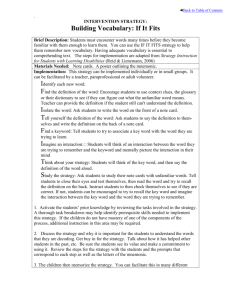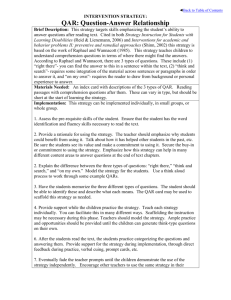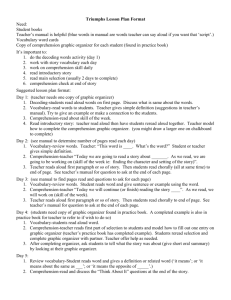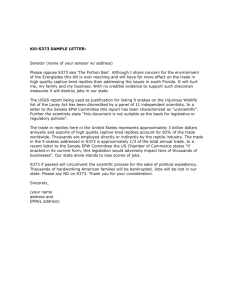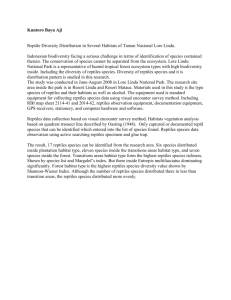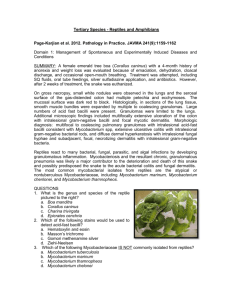INTERVENTION STRATEGY:
advertisement
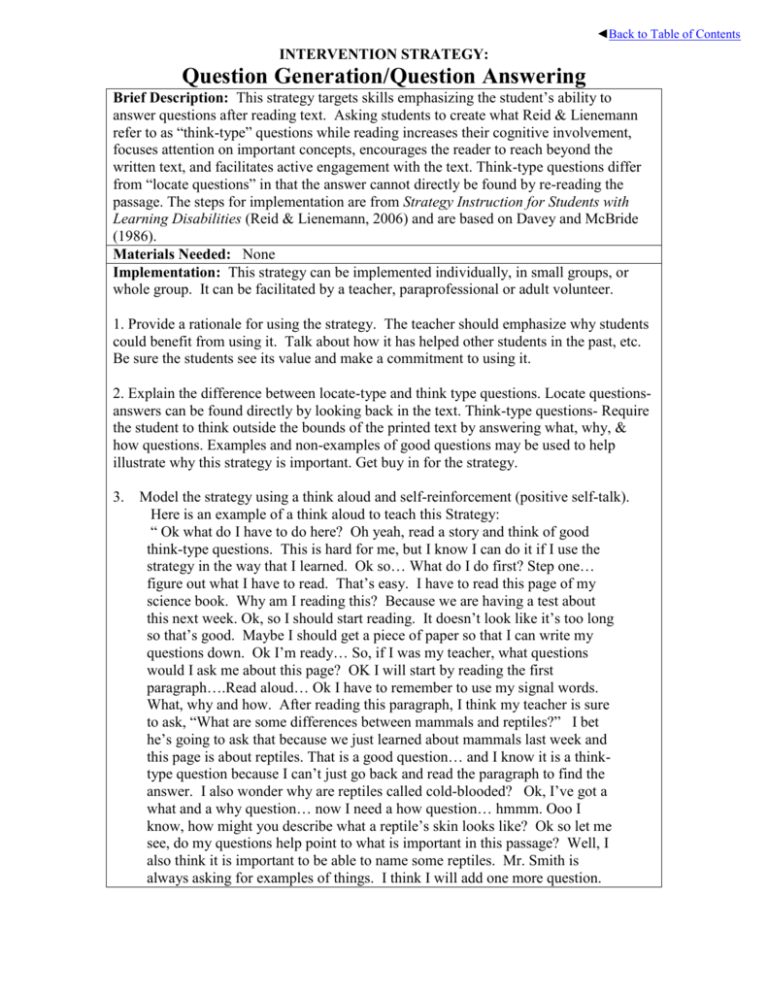
◄Back to Table of Contents INTERVENTION STRATEGY: Question Generation/Question Answering Brief Description: This strategy targets skills emphasizing the student’s ability to answer questions after reading text. Asking students to create what Reid & Lienemann refer to as “think-type” questions while reading increases their cognitive involvement, focuses attention on important concepts, encourages the reader to reach beyond the written text, and facilitates active engagement with the text. Think-type questions differ from “locate questions” in that the answer cannot directly be found by re-reading the passage. The steps for implementation are from Strategy Instruction for Students with Learning Disabilities (Reid & Lienemann, 2006) and are based on Davey and McBride (1986). Materials Needed: None Implementation: This strategy can be implemented individually, in small groups, or whole group. It can be facilitated by a teacher, paraprofessional or adult volunteer. 1. Provide a rationale for using the strategy. The teacher should emphasize why students could benefit from using it. Talk about how it has helped other students in the past, etc. Be sure the students see its value and make a commitment to using it. 2. Explain the difference between locate-type and think type questions. Locate questionsanswers can be found directly by looking back in the text. Think-type questions- Require the student to think outside the bounds of the printed text by answering what, why, & how questions. Examples and non-examples of good questions may be used to help illustrate why this strategy is important. Get buy in for the strategy. 3. Model the strategy using a think aloud and self-reinforcement (positive self-talk). Here is an example of a think aloud to teach this Strategy: “ Ok what do I have to do here? Oh yeah, read a story and think of good think-type questions. This is hard for me, but I know I can do it if I use the strategy in the way that I learned. Ok so… What do I do first? Step one… figure out what I have to read. That’s easy. I have to read this page of my science book. Why am I reading this? Because we are having a test about this next week. Ok, so I should start reading. It doesn’t look like it’s too long so that’s good. Maybe I should get a piece of paper so that I can write my questions down. Ok I’m ready… So, if I was my teacher, what questions would I ask me about this page? OK I will start by reading the first paragraph….Read aloud… Ok I have to remember to use my signal words. What, why and how. After reading this paragraph, I think my teacher is sure to ask, “What are some differences between mammals and reptiles?” I bet he’s going to ask that because we just learned about mammals last week and this page is about reptiles. That is a good question… and I know it is a thinktype question because I can’t just go back and read the paragraph to find the answer. I also wonder why are reptiles called cold-blooded? Ok, I’ve got a what and a why question… now I need a how question… hmmm. Ooo I know, how might you describe what a reptile’s skin looks like? Ok so let me see, do my questions help point to what is important in this passage? Well, I also think it is important to be able to name some reptiles. Mr. Smith is always asking for examples of things. I think I will add one more question. “What are some reptiles?” OK so, now I need to answer my questions. (Continue the think-aloud until all of the questions have been answered). 4. The children then practice the strategy. You can facilitate this in many different ways. Scaffolding the instruction may be necessary during this phase. Ample practice and opportunities should be provided until the children can generate think-type questions on their own. 6. Provide support for the strategy during implementation, through direct feedback during practice, verbal cuing, prompt cards, etc. 7. Eventually fade the teacher prompts until the children demonstrate the use of the strategy independently. Encourage other teachers to use the same strategy in their classrooms as well. Schedule for implementation: The procedure should be taught until students have mastered the steps and use the strategy independently. Reinforcement of the strategy should occur daily. Variations: A personal index card with the steps on it may be helpful as children learn the strategy. A structured Self-Monitoring strategy checklist may be incorporated. One can be found on p. 155 of the Reid and Lienemann book referenced below and reproduced by purchasers of that text. Teachers may also use a graphic organizer to structure the task for students and may be used as a study guide for tests. An example is provided under the tools section. Research Summary & References: Reid, R. & Lienemann, T. (1996). Strategy Instruction for Students with Learning Disabilities, New York, NY: Guilford Press. Davey, B., & McBride, S. (1986). Effects of question-generation training on reading comprehension. Journal of Educational Psychology, 78, 256-262. Tool/Attachments: The file “Think Aloud” in the tools folder on this CD contains more information about using think alouds to teach children metacognitive processes. The file “Question Generation Graphic” in the tools folder on this CD contains a graphic organizer to help students use this strategy. This may be used as a tool to scaffold instruction or be used as a study aid for tests.
